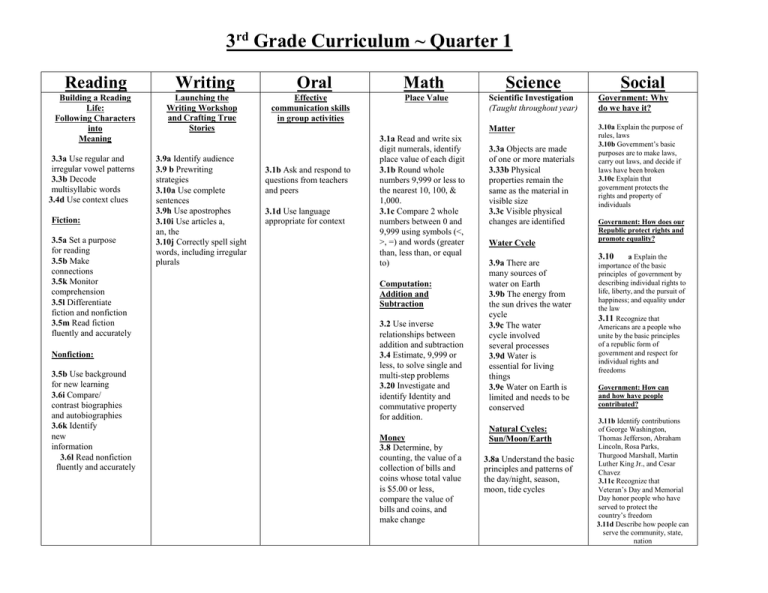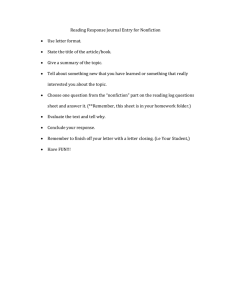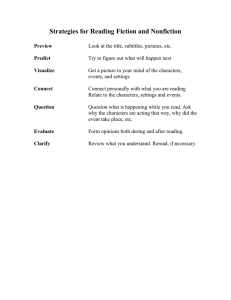3 Grade Curriculum ~ Quarter 1 Reading
advertisement

3rd Grade Curriculum ~ Quarter 1 Reading Building a Reading Life: Following Characters into Meaning 3.3a Use regular and irregular vowel patterns 3.3b Decode multisyllabic words 3.4d Use context clues Fiction: 3.5a Set a purpose for reading 3.5b Make connections 3.5k Monitor comprehension 3.5l Differentiate fiction and nonfiction 3.5m Read fiction fluently and accurately Nonfiction: 3.5b Use background for new learning 3.6i Compare/ contrast biographies and autobiographies 3.6k Identify new information 3.6l Read nonfiction fluently and accurately Writing Launching the Writing Workshop and Crafting True Stories 3.9a Identify audience 3.9 b Prewriting strategies 3.10a Use complete sentences 3.9h Use apostrophes 3.10i Use articles a, an, the 3.10j Correctly spell sight words, including irregular plurals Oral Effective communication skills in group activities 3.1b Ask and respond to questions from teachers and peers 3.1d Use language appropriate for context Math Science Place Value Scientific Investigation (Taught throughout year) Government: Why do we have it? Matter 3.10a Explain the purpose of rules, laws 3.10b Government’s basic purposes are to make laws, carry out laws, and decide if laws have been broken 3.10c Explain that government protects the rights and property of individuals 3.1a Read and write six digit numerals, identify place value of each digit 3.1b Round whole numbers 9,999 or less to the nearest 10, 100, & 1,000. 3.1c Compare 2 whole numbers between 0 and 9,999 using symbols (<, >, =) and words (greater than, less than, or equal to) Computation: Addition and Subtraction 3.2 Use inverse relationships between addition and subtraction 3.4 Estimate, 9,999 or less, to solve single and multi-step problems 3.20 Investigate and identify Identity and commutative property for addition. Money 3.8 Determine, by counting, the value of a collection of bills and coins whose total value is $5.00 or less, compare the value of bills and coins, and make change 3.3a Objects are made of one or more materials 3.33b Physical properties remain the same as the material in visible size 3.3c Visible physical changes are identified Water Cycle 3.9a There are many sources of water on Earth 3.9b The energy from the sun drives the water cycle 3.9c The water cycle involved several processes 3.9d Water is essential for living things 3.9e Water on Earth is limited and needs to be conserved Natural Cycles: Sun/Moon/Earth 3.8a Understand the basic principles and patterns of the day/night, season, moon, tide cycles Social Government: How does our Republic protect rights and promote equality? 3.10 a Explain the importance of the basic principles of government by describing individual rights to life, liberty, and the pursuit of happiness; and equality under the law 3.11 Recognize that Americans are a people who unite by the basic principles of a republic form of government and respect for individual rights and freedoms Government: How can and how have people contributed? 3.11b Identify contributions of George Washington, Thomas Jefferson, Abraham Lincoln, Rosa Parks, Thurgood Marshall, Martin Luther King Jr., and Cesar Chavez 3.11c Recognize that Veteran’s Day and Memorial Day honor people who have served to protect the country’s freedom 3.11d Describe how people can serve the community, state, nation 3rd Grade Curriculum ~ Quarter 2 Reading Writing Oral Math Science Social Nonfiction Reading: Expository Texts Informational Writing: Expert Pieces Effective communication skills in group activities Computation: Division and Multiplication 3.5 Recall multiplication 3.9a Identify audience 3.3a Use regular and irregular vowel patterns 3.3b Decode multisyllabic words 3.4c Apply meaning clues, language structure, & phonetic strategies 3.4e Discuss meanings of words to develop vocab 3.9 b Use a variety of prewriting strategies Fiction: 3.10f Commas in a series and division facts to 12 3.6 Represent multiplication and division using area, set, and number lines to create and solve problems involving multiplying a factor 99 or less and 5 or less. 3.19 Recognize and extend patterns formed using numbers, tables, and pictures 3.20 Investigate and identify examples of the identity and commutative properties of multiplication 3.10g Abbreviations Patterns and Data 3.5c Make, confirm, revise predictions 3.5h Identify problem and solution 3.5i Identify main idea 3.5j Identify supporting details 3.5k Monitor comprehension 3.5m Read fiction fluently and accurately Nonfiction: 3.5c Preview text features 3.6d Ask and answer questions from text 3.6e Draw conclusions 3.6h Identify supporting details 3.6l Read nonfiction fluently and accurately 3.7b Use table of contents, indices and charts 3.9g Revise writing for clarity of content 3.1a Listen attentively by making eye contact, facing the speaker, asking questions and summarizing what has been said. 3.10b Transition words 3.10d Past/present tense 3.10j Correctly spell sight words, including irregular plurals 3.1c Explain what has been learned 3.17a Collect and organize data using observations, measurements, surveys, or experiments 3.17b Construct a line plot, a picture graph, or bar graph 3.17c Read and interpret data represented in line plots, bar graphs, and picture graphs and write a sentence analyzing the data 3.19 Recognize and extend patterns formed using numbers, tables, and pictures Geometry 3.14 Identify, describe, compare and contrast characteristics of plane and solid geometric by identifying characteristics including the number of angles, vertices, edges, as well as the number and shape of faces 3.15 Identify and draw points, line segments, lines, rays, and angles 3.16 Identify and describe congruent and non-congruent shapes Scientific Investigation (Taught throughout year) Mechanics of Geography: Hemispheres Energy Resources 3.11 Investigate and understand different sources of energy 3.2c Compound machine Simple and Compound Machines 3.2a Purpose and function of simple machines 3.2b Types of simple machines 3.2d Examples of simple and compound machines found in the school, home, and work environments 3.5a Position and label the seven continents and five oceans 3.5b Develop map skills by using the equator and prime meridian to identify the four hemispheres Mechanics of Geography: Read and construct maps, charts, and graphs 3.5 Read and construct maps, tables, graphs, and charts Mechanics of Geography: Location 3.4 Locate Greece, Rome, and West Africa 3.5c Locate Spain, England, and France 3.5e Locate specific places using a simple letternumber grid system 3rd Grade Curriculum ~ Quarter 3 Reading Folklore & Fairytales 3.3a Use regular and irregular vowel patterns 3.3b Decode multisyllabic words 3.3a Homophones 3.4b Roots, affixes, synonyms, and antonyms 3.4f Use vocab from other content areas 3.4g Use glossary, dictionary, and thesaurus Fiction: 3.4d Compare and contrast setting, characters, and events 3.5e Identify author’s purpose 3.5f Ask and answer questions from text 3.5g Draw conclusions 3.5k Monitor comprehension 3.5m Read fiction fluently and accurately Nonfiction: 3.5a Identify Author’s purpose 3.6d Ask and answer questions from text 3.6e Draw conclusions 3.6g Identify Main Idea Writing Persuasive Writing 3.8 Write legibly in cursive 3.9a Identify audience 3.9 b Use a variety of prewriting strategies 3.9c Clear topic sentence 3.9d One topic paragraph 3.9f Details to elaborate 3.9g Revise writing for clarity 3.10c Use I in compound subjects 3.10e Use singular possessives 3.10j Correctly spell sight words and irregular plurals Oral Effective communication skills in group activities 3.1e Increase listening and speaking vocabularies 3.2 present brief oral report using visual media: 3.2a speak clearly 3.2b use appropriate volume and pitch Math Science Fractions & Probability Scientific Investigation (Taught throughout year) 3.3 Name, write fractions and mixed numbers represented by a model 3.18 Investigate and describe probability as chance and list possible results Computation: Add and Subtract Fractions 3.2c speak at an understandable rate 3.7 Add, subtract proper fractions having like denominators of 12 or less 3.2d organize ideas sequentially or around major points of information Elapsed Time and Temperature 3.2e use contextually appropriate language and specific vocabulary to communicate ideas 3.11 a Tell time to the nearest minute using analog and digital clocks 3.11b Determine elapsed time in one hour increments over a 12hour period 3.12 Identify equivalent periods of time, including relationships among days, months, and years as well as minutes and hours 3.13 Read temperature to the nearest degree from a Celsius and Fahrenheit thermometer Land and Water Environments 3.6a Aquatic ecosystems 3.6b Terrestrial ecosystems 3.6c Populations and Communities 3.6d The human role in conserving limited resources Natural Cycles: Plant 3.8c Understand the basic principles and patterns of the plant life cycle Social Geography’s Effects: Resources of Mali 3.2 Describe Mali’s oral tradition (storytelling), government (kings), and economic development (trade) 3.4b Describe the physical and human characteristics of West Africa 3.4c Explain how people of West Africa adapted to their environment to meet their needs 3.7 Explain how producers in Mali used natural, human, and capital resources in the production of goods and services Geography’s Effects: Resources of Greece 3.4b Same as above, but for ancient Greece 3.4c Same as above, but for ancient Greece 3.7 Same as above, but for ancient Greece 3.1 Explain how the contributions of ancient Greece and Rome have influenced the present world in terms of architecture, government (direct and indirect democracy), and sports Geography’s Effects: Resources of Rome 3.4b Same as above, but for ancient Rome 3.4c Same as above, but for ancient Rome 3.7 Same as above, but for ancient Rome Economy: How people in certain places meet their needs 3.8 Recognize that because people and regions cannot produce everything they want, they specialize in what they do best and trade for the rest 3.6l Read nonfiction fluently and accurately 3.7a Use encyclopedias and other references books as well as online resources Identify examples of making economic choices and explain the idea of opportunity cost (what’s given up) ~~~~~~~~~~~~~~~ Famous African Americans 3rd Grade Curriculum ~ Quarter 4 Reading Informational Reading: Reading, Research Poetry 3.3a Use regular and irregular vowel patterns 3.3b Multisyllabic words 3.4b Roots, affixes, synonyms, and antonyms 3.4g Use glossary, dictionary, and thesaurus Fiction: 3.5d Compare and contrast setting, characters, and events 3.5e Identify author’s purpose 3.5g Draw conclusions 3.5k Monitor comprehension 3.5m Read fiction fluently and accurately Nonfiction: 3.6a Identify Author’s purpose 3.6e Draw conclusions Writing Research Based Nonfiction Oral Effective communication skills in group activities 3.9a Identify audience 3.2a Speak clearly 3.9 b Use a variety of prewriting strategies 3.2b Use appropriate volume and pitch 3.9c Clear topic sentence 3.2c Speak at an understandable rate 3.9d One topic paragraph 3.2d Organize ideas sequentially or around major points of information 3.9e Use strategies for organization of information and elaboration according to the type of writing 3.2e Use context appropriate language and specific vocabulary to communicate ideas Math Science Measuring Our World: length, weight, volume, area and perimeter. Scientific Investigation 3.9 Estimate and use US Customary and metric units to measure: a. Length to the nearest ½ inch, foot, yard, centimeter, and meter b. Liquid volume in cups, pints, quarts, gallons, and liters c. Weight/mass in ounces, pounds, grams, and kilograms d. Area and perimeter Measuring length, Area, and Perimeter 3.9f Details to elaborate 3.9g Revise writing for clarity 3.10j Correctly spell sight words, including irregular plurals 3.11d Understand plagiarism vs. own words Soil 3.7a Soil provides support and nutrients for plant growth 3.7b Topsoil is a natural product of subsoil and bedrock 3.7c Rock, clay, silt, sand, and humus are the components of soil 3.7d Soil is a natural resource that should be conserved Impact of History: Mixed Effects Animal Adaptations 3.3b Identify the reasons for exploring, the information gained, the results of the travels, and the impact of the travels on American Indians 3.4a Behavioral adaptations animals do to satisfy their life’s needs 3.4b Physical adaptations animal have to satisfy their life’s needs Food Chains ~~~~~~~~~~~~ Animal Exhibit 3.9a Estimate and use US Customary and metric units to measure length to the nearest ½ inch, foot, yard, centimeter, and meter 3.9d Estimate and use area and perimeter 3.10a Measure the distance around a polygon in order Social Impact of History: Contributions 3.5a Producer, consumer, decomposer 3.5b Herbivore, carnivore, omnivore 3.5c Predator and prey Natural Cycles: Animal 3.8b Understand the basic principles and patterns of the animal life cycle 3.3a Describe the accomplishments of Christopher Columbus, Juan Ponce de Leon, Jacques Cartier, and Christopher Newport 3.5d Locate the regions in the Americas explored by Christopher Columbus (San Salvador in the Bahamas), Juan Ponce de Leon (near St. Augustine, Florida), Jacques Cartier (near Quebec, Canada), and Christopher Newport (Jamestown, Virginia) 3.6f Summarize major points 3.6j Use reading strategies to monitor comprehension 3.6l Read nonfiction fluently and accurately 3.7a Use encyclopedias and other references books & online resources 3.6b Use table of contents, indices and charts 3.10a Construct questions about the topics 3.11b Identify appropriate resources 3.11c Collect and organize information to determine perimeter 3.10b count the number of square units needed to cover a surface in order to determine area Survival of Organisms 3.10a The interdependency of plants and animals 3.10b The effects of human activity on the quality of air, water, and habitat 3.10c The effects of fire, flood, disease, and erosion on organisms 3.10d Conservation and resource renewal


